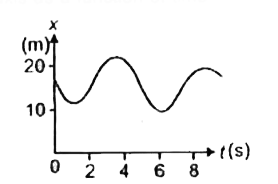A particle is fixed to the edge of a disk that is rotating uniformly in anticlockwise direction about its central axis. At time t=0 the particle is on the X axis at the position shown in figure and it has velocity v

(a) Draw a graph representing the variation of the x component of the velocity of the particle as a function of time.
(b) Draw the y-component of the acceleration of the particle as a function of time.
The correct Answer is:(##IJAPHYV01C02E01045_A01##)
Step by step video, text & image solution for A particle is fixed to the edge of a disk that is rotating uniformly in anticlockwise direction about its central axis. At time t = 0 the particle is on the X axis at the position shown in figure and it has velocity v (a) Draw a graph representing the variation of the x component of the velocity of the particle as a function of time. (b) Draw the y-component of the acceleration of the particle as a function of time. by Physics experts to help you in doubts & scoring excellent marks in Class 11 exams.
Updated on:21/07/2023Topper's Solved these Questions
- KINEMATICSBook:ARIHANTChapter:KINEMATICSExercise:Level 2
Explore 58 Videos
- KINEMATICSBook:ARIHANTChapter:KINEMATICSExercise:Level 3
Explore 33 Videos
- HEAT TRANSFERBook:ARIHANTChapter:HEAT TRANSFERExercise:Heat Transfer
Explore 45 Videos
- KINETIC THEORY OF GASESBook:ARIHANTChapter:KINETIC THEORY OF GASESExercise:Level 3
Explore 4 Videos
Similar Questions
Knowledge Check
Figure shows the position of a particle moving on the X-axis as a function of time.
 AThe particle has come to rest 6 timesBThe maximum speed is at t=6 s.CThe velocity remains positive for t=0 to t=6s.DThe average velocity for the total period shown is negative
AThe particle has come to rest 6 timesBThe maximum speed is at t=6 s.CThe velocity remains positive for t=0 to t=6s.DThe average velocity for the total period shown is negativeFigure shows the position of a particle moving on the x - axis as a function of time
 AThe particle has come to rest 4 timesBThe velocity at t = 8 s is negativeCThe velocity remains positive for t = 2 s to t = 6 sDThe particle moves with constant velocity.
AThe particle has come to rest 4 timesBThe velocity at t = 8 s is negativeCThe velocity remains positive for t = 2 s to t = 6 sDThe particle moves with constant velocity.A particle moving in the positive x-direction has initial velocity v0. The particle undergoes retardation kv2 , where vis its instantaneous velocity. The velocity of the particle as a function of time is given by:
Av=v0/(1+kv0t)Bv=2v01+ktCv=v0ktDv=v0(1+k2v02t)
A particle moving in the positive x-direction has initial velocity v0. The particle undergoes retardation kv2 , where vis its instantaneous velocity. The velocity of the particle as a function of time is given by:
View SolutionFigure shows the position the graph for a particle in one dimensional motion. Which of the graphs in fugure represent the variation in the velocity of the particle with time ?

View SolutionThe velocity -time (v−t) graph of a particle moving in a straight line is shown in figure. The acceleration of the particle at t=9 is:

View SolutionThe acceleration of a particle which moves along the positive x-axis varies with its position as shown in figure. If the velocity of the particle is 0.8ms−1 at x = 0, then velocity of the particle at x=1.4m is (∈ms−1).

View SolutionA particle is moving parallel to x-axis as shown in the figure. The angular velocity of the particle about the origin is

View Solution


